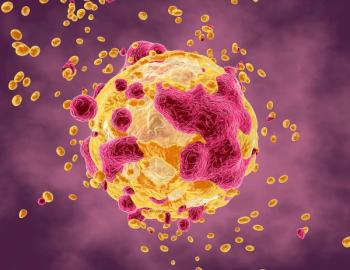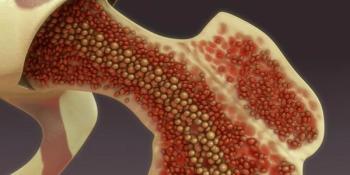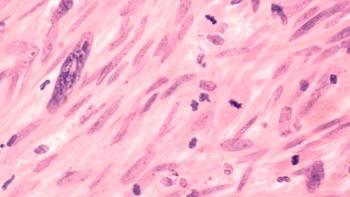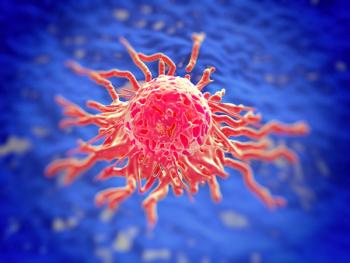
- ONCOLOGY Vol 10 No 6
- Volume 10
- Issue 6
The Epidemiologic Scope of Kaposi's Sarcoma
The unique epidemiology of Kaposi's sarcoma among patients with the acquired immunodeficiency syndrome suggests a multifactorial cause. Although the human immunodeficiency virus (HIV) plays a major role in the
ABSTRACT: The unique epidemiology of Kaposi's sarcomaamong patients with the acquired immunodeficiency syndrome suggestsa multifactorial cause. Although the human immunodeficiency virus(HIV) plays a major role in the pathogenesis of this condition,it is not the sole cause. Other factors, such as a second sexuallytransmitted organism, genetics, and nitrite inhalant use, maypredispose HIV-infected persons to Kaposi's sarcoma. [ONCOLOGY10(Suppl):9-12, 1996]
Kaposi's sarcoma (KS) is best known in the United States in associationwith acquired immunodeficiency syndrome (AIDS). Worldwide, however,the AIDS-related form is only one of four clinical presentationsof the disease. Much remains unknown about the pathogenesis ofAIDS-related KS. Some aspects of the epidemiology of the fourtypes, as well as the changing picture of AIDS-related KS, mayprovide important leads to understanding the etiology(ies) ofthese neoplasms.
The four types of KS are the classic form, the African form, theform associated with iatrogenic immunosuppression, and the AIDS-relatedform. The classic form of KS was first described as "idiopathic,multiple pigmented sarcomas of the skin" in 1872 by MoritzKaposi, a Viennese dermatologist"[1]. Kaposi's descriptionwas based on the examination of three elderly men who had lesionson their extremities. Since the publication of Kaposi's originalpaper, this form of KS has been observed worldwide, although itseems to be more prevalent in people of Mediterranean origin.It is not rapidly progressive, and the male-to-female ratio is10 to 15:1. A typical patient might present with KS in his 60sand live another 10 or 15 years before dying of some unrelatedcause [2].
The African endemic form of KS was first described in 1914, butits prevalence in Africa was only appreciated approximately 20years later, when a review of 500 tumors in Nigerian patientsshowed 2% to be KS [3,4]. The African form occurs predominantlyin young, black adults 25 to 40 years of age. The male-to-femaleratio for this form is 17:1. The presentation is variable. Benign,nodular lesions limited to the extremities form one end of thespectrum; florid, disseminated lesions are at the other end. Survivalranges from 3 to 10 years following presentation. There is alsoa lymphadenopathic subvariant of the African form that affectschildren at a mean age of 3 years. The male-to-female ratio forthis pediatric subvariant is 3:1 [2].
In the 1970s, a third form of KS was observed in immunocompromisedpatients. Such patients who are at risk for this form of KS includerecipients of renal transplant, patients on long-term corticosteroidsfor various disorders, and patients who are immunosuppressed asa result of some other therapeutic regimen or malignancy. As withthe African form, with the immunocompromised form, lesions areoften localized, although rapid dissemination is seen in somecases. The male-to-female ratio for this form is 2.3:1. One uniqueaspect of this form of KS is that some lesions resolve when iatrogenicimmunosuppression is stopped [2].
In 1981, a major epidemic of the fourth type of KS was discovered.The AIDS-related form occurs in conjunction with human immunodeficiencyvirus (HIV) infection and is found predominantly among white,homosexual/bisexual men. In contrast to the other three forms,in which lesions tend to appear on the legs, AIDS-related KS mayappear on the extremities but also commonly appears on the chestand face (Figure 1) as well as in the gastrointestinal tract andlungs. Disease is also more virulent with this form than withthe other three forms, and most patients die of KS or other AIDS-definingillnesses within 1 to 3 years of presentation. The male-to-femaleratio for the AIDS-related form is 100:1 [2].
There may be some confusion about presentation when forms of KSintersect. For example, as the AIDS epidemic spreads in Africa,AIDS-related KS is overtaking the endemic African form in frequency.Researchers from Zambia report that the prevalence of KS is increasingin tandem with that of HIV infection. The male-to-female ratiofor all cases of KS dropped from 10:1 in 1985 to 2.3:1 in 1993.The HIV seroprevalence in Zambian cases of KS is 97% [5]. Anotherexample is the juxtaposition of HIV-positive and HIV-negativepatients with KS among homosexual men in the United States. Comparedwith HIV-positive patients, HIV-negative patients are older (medianage, 49 years vs 37 years), less immunosuppressed (median CD4counts, 768 vs 226 cells/mm³), and have more indolent clinicalcourses (less than10 skin lesions for all HIV-negative patients)[6].
In 1981, the Centers for Disease Control and Prevention (CDC)in Atlanta, Georgia, initiated surveillance of AIDS in the UnitedStates. Between June 1981 and December 31, 1992, a total of 253,322cases of patients with AIDS were reported. Presumptive or definitiveKS was reported in 33,170 patients (13%). There are three caveatsregarding the interpretation of these figures. First, the definitionof AIDS and AIDS-related KS changed several times during the surveillanceprocess. Second, approximately 20% of cases of KS are diagnosedwithout benefit of biopsy; this is particularly common in patientswith other manifestations of AIDS, who are often diagnosed withKS on clinical grounds alone. Third, there are cases of KS thatgo unreported when patients with AIDS develop KS in the laterstages of disease, after AIDS has already been reported [7].
Despite these limitations, several observations can be made fromthe surveillance data. First, homosexual/bisexual men are muchmore likely to develop KS than are patients from other groups(Table 1). More than 30,000 of the 33,170 AIDS-related cases ofKS have occurred among homosexual/bisexual men, a rate of KS of19.2% in the homosexual/bisexual patient population with AIDS.In other groups, the rate ranges from 0.5% to 5.6%. This differenceis highly significant.
Second, the incidence of AIDS-related KS increased each year from1981 through 1990. However, unlike total cases of AIDS, whichhave continued to increase, the incidence of AIDS-related KS declinedin 1991 and 1992. In fact, the proportion of cases of AIDS withKS has declined each year since surveillance began (Table 2).
Third, among blood transfusion-related cases of AIDS, 42 donor-recipientpairs developed AIDS. There were no cases in which the recipientdeveloped KS after receiving transfusion from donors who laterdeveloped KS. In one case, a recipient developed KS after receivingHIV-infected blood from a donor who did not develop KS. If AIDS-relatedKS was caused by HIV alone or a special strain(s) of HIV, someconcordance of KS between donors and recipients would be expected[7].
Fourth, among homosexual/bisexual men with AIDS, KS is more commonin white men than in black men (22% vs 10%) [7,8].
Fifth, initial data showed that women who were sexual partnersof homosexual men were more likely to develop KS than women sexuallylinked to injection drug users (3% vs 0.9%) [9]. The gap betweenthese groups is narrowing, however, and is no longer statisticallysignificant (Table 3) [7]. Women who reported intravenous drugabuse or a history of blood transfusion prior to the diagnosisof AIDS were excluded from analysis.
Finally, the rate of KS among patients with AIDS varies with location.The proportion of white, homosexual patients with AIDS and KSis more than 20% in California, Connecticut, the District of Columbia,Massachusetts, New Mexico, New York, and South Carolina but lessthan 10% in Alabama, Arkansas, Iowa, Nevada, and Utah [7].
The unique epidemiology of KS among patients with AIDS suggeststhat its cause is multifactorial. Although HIV plays a major rolein its pathogenesis, HIV alone is not its cause. Data suggestthat a necessary factor(s), and/or enhancing factor(s), associatedwith a homosexual life-style predisposes HIV-infected personsto KS. A second sexually transmitted organism, a fecal-orallytransmitted organism, genetics, and nitrite inhalant use havebeen proposed as cofactors. The current epidemic of AIDS-relatedKS provides a unique opportunity to decipher the pathogenesisof a malignancy that is multifactorial in etiology.
References:
1. Kaposi M: Idiopathisches multiples Pigmentsarkom der Haut.Arch Dermatol Syph 4:265-273, 1872.
2. Friedman-Kien AE: Color Atlas of AIDS. Philadelphia, WB SaundersCo, 1989.
3. Hallenberger O: Multiple Angiosarkome der Haut bei einem Kamerunneger.Arch Schiffs Trop Hyg 18:647-651, 1914.
4. Smith EC, Elmes BGT: Malignant disease in natives of Nigeria:An analysis of 500 tumours. Ann Trop Med Parasitol 28:461-513,1934.
5. Ebrahim SH, Sunkutu MR, Mwansa N: Epidemiological and clinicalfeatures of Kaposi's sarcoma in adults in Zambia (abstract WS-B15-1).Proceedings of the IX International Conference on AIDS. Berlin,Germany, June 6-11, 1993.
6. Saltzman BR, Friedman-Kien AE, Huang YQ, et al: Epidemic Kaposi'ssarcoma in HIV uninfected (HIV-neg) homosexual (HS) men: Clinicalcourse and analysis for known human retroviral genomic sequencesby PCR (abstract ThB 1543). Proceedings of the XIII InternationalConference on AIDS. Amsterdam, Netherlands, July 19-24, 1992.
7. Haverkos HW, Drotman DP: Epidemiology of AIDS-related Kaposi'ssarcoma (KS): An update (abstract PO-B12-1576). Proceedings ofthe IX International Conference on AIDS. Berlin, Germany, June6-11, 1993.
8. Haverkos HW, Drotman DP, Morgan WM: Kaposi's sarcoma in patientswith AIDS: Sex, transmission mode, and race. Biomed Pharmacother44:461-466, 1990.
9. Beral V, Peterman TA, Berkelman RL, et al: Kaposi's sarcomaamong patients with AIDS: A sexually transmitted infection? Lancet335:123-127, 1990.
Articles in this issue
over 29 years ago
AIDS-related Kaposi's Sarcoma: Options for Today and Tomorrowover 29 years ago
Clinical Manifestations of Kaposi's Sarcomaover 29 years ago
New Developments: A Look to the Futureover 29 years ago
Current Therapeutic Options for Kaposi's Sarcomaover 29 years ago
Discussionover 29 years ago
Comments on Bone Marrow Transplantation for Multiple Myelomaover 29 years ago
Medicine as Business May Mean More Ethical Challenges for PhysiciansNewsletter
Stay up to date on recent advances in the multidisciplinary approach to cancer.





